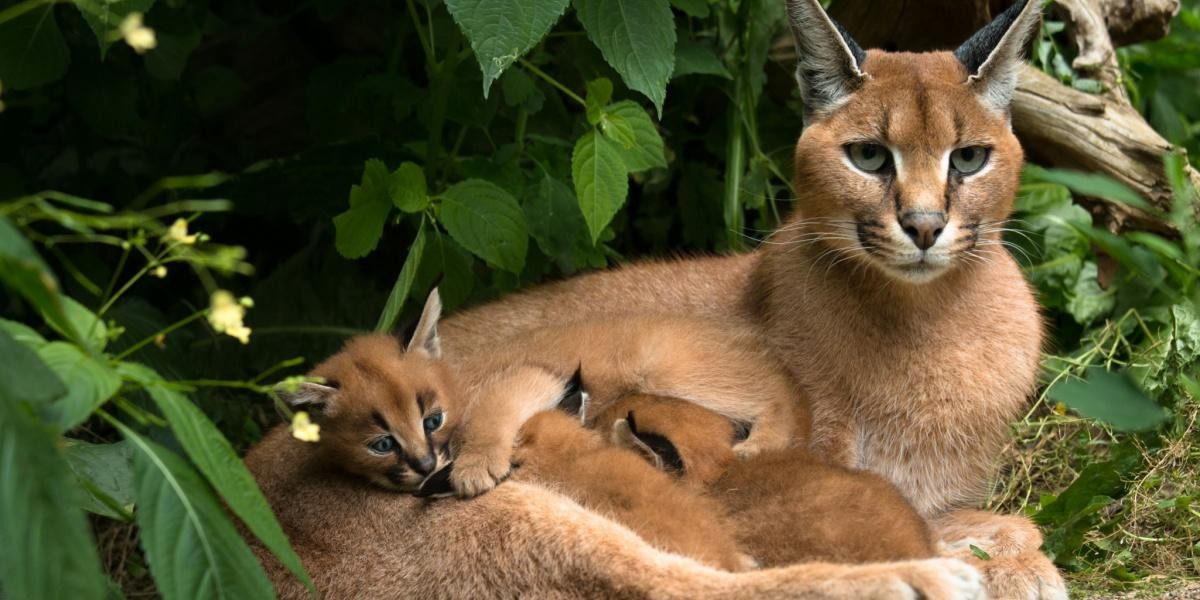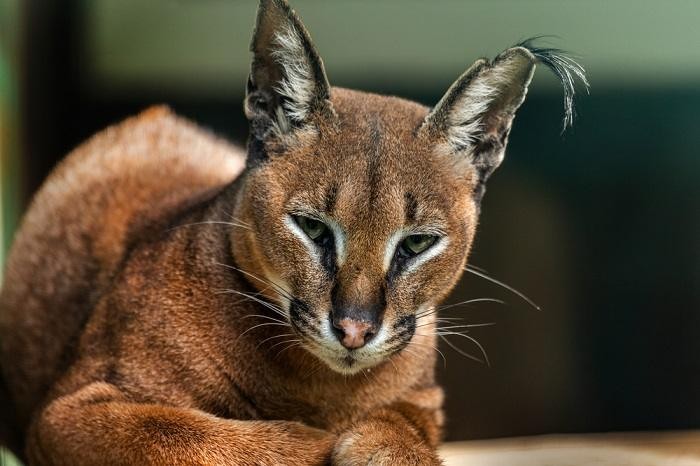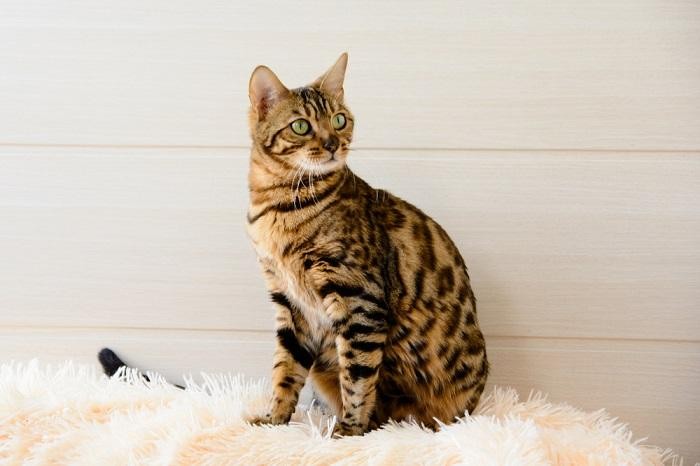Can You Keep A Floppa As A Pet? Discover the realities, legalities, and ethical considerations of owning a caracal. Pets.edu.vn offers expert guidance to help you make informed decisions about exotic pet ownership and find resources for responsible pet care. Explore alternative cat breeds that resemble the floppa’s wild beauty without the challenges of keeping a wild animal.
1. Understanding the Caracal: The “Floppa” Phenomenon
The caracal, scientifically known as Caracal caracal, has captured the internet’s attention with the endearing nickname “Floppa,” primarily due to its strikingly large, tufted ears and expressive face. These medium-sized wild cats are native to Africa, Central Asia, India, and the Middle East. Their name originates from the Turkish word “karakulak,” meaning “black ear,” a nod to the distinctive black fur on the back of their ears. But can these captivating creatures truly be kept as pets? Let’s delve deeper into the world of the caracal.
1.1. Caracal Characteristics
Caracals possess several unique physical characteristics:
- Size: Adult caracals typically weigh between 20 and 40 pounds (9 to 18 kg), significantly larger than the average domestic cat.
- Appearance: They have a sleek, muscular build with a short, dense coat that ranges in color from tawny to reddish-brown. Their most recognizable feature is their long, black-tufted ears, which are believed to aid in their exceptional hearing capabilities, essential for hunting.
- Habitat: In their natural habitat, caracals are highly adaptable, thriving in a variety of environments, including savannas, woodlands, and scrublands.
1.2. Caracal Behavior
Understanding a caracal’s natural behaviors is crucial when considering them as potential pets:
- Solitary Nature: Caracals are primarily solitary animals, preferring to hunt and live alone. This can pose challenges in a domestic environment where they may not easily adapt to living with other pets or frequent human interaction.
- Hunting Instincts: These cats are skilled hunters with strong predatory instincts. They are capable of catching birds in flight and often prey on rodents, hares, and small ungulates.
- Territoriality: Caracals are highly territorial, marking their territory with urine spraying and scratching. This behavior can be problematic indoors, leading to damage and unsanitary conditions.
2. Legality of Owning a Caracal
The legality of owning a caracal varies significantly depending on your location:
- United States: Laws concerning exotic animal ownership are determined at the state level. Some states have strict bans on owning wild cats like caracals, while others require permits or licenses. A few states have no specific regulations.
- Europe: Many European countries have restrictions on owning exotic animals, with some countries requiring special permits or banning ownership altogether.
- Other Regions: Regulations in other parts of the world vary widely. It’s essential to research local laws and regulations before considering caracal ownership.
Disclaimer: Even if caracal ownership is legal in your area, it doesn’t necessarily mean it’s a suitable or ethical choice.
3. Ethical Considerations
Beyond the legal aspects, ethical considerations play a vital role in deciding whether to keep a caracal as a pet:
- Animal Welfare: Caracals are wild animals with specific needs that are difficult to meet in a domestic setting. Confinement can lead to stress, behavioral problems, and a diminished quality of life.
- Conservation: The demand for caracals as pets can fuel illegal poaching and trade, threatening wild populations.
- Public Safety: Caracals are powerful animals with sharp teeth and claws. Even well-intentioned owners may struggle to manage their caracal’s natural instincts, posing a risk to themselves, their families, and the community.
4. Challenges of Caracal Ownership
Even under the best circumstances, caracal ownership presents numerous challenges:
- Housing: Caracals require large, secure enclosures to prevent escape and ensure their safety. These enclosures must provide ample space for exercise, climbing, and natural behaviors.
- Diet: Caracals have a specialized diet consisting primarily of raw meat, bones, and organs. Meeting their nutritional needs can be expensive and time-consuming.
- Veterinary Care: Finding a veterinarian experienced in treating exotic cats can be difficult. Caracals require specialized care, including vaccinations, parasite control, and treatment for potential health issues.
- Behavioral Issues: Caracals may exhibit destructive behaviors, such as scratching furniture, spraying urine, and aggression towards humans and other pets.
- Socialization: Caracals are not naturally social animals and may not adapt well to living with other pets or frequent human interaction.
- Long-Term Commitment: Caracals can live for 12 to 18 years in captivity, requiring a long-term commitment from their owners.
5. Why Caracals Are Not Suitable Pets
While some individuals may claim to have successfully kept caracals as pets, the reality is that these animals are fundamentally unsuited for domestic life:
- Wild Instincts: Caracals retain their wild instincts, regardless of how they are raised. These instincts can manifest in unpredictable and potentially dangerous behaviors.
- Inability to Thrive: Even in the most enriched environments, caracals cannot fully express their natural behaviors or experience the freedom and autonomy they would have in the wild.
- Public Safety Concerns: Caracals pose a risk to public safety due to their strength, agility, and predatory instincts.
- Ethical Considerations: Keeping a caracal as a pet is ethically questionable due to the animal welfare and conservation concerns outlined above.
6. Caracal Diet and Nutritional Needs
Caracals are obligate carnivores, meaning their diet must consist primarily of meat to meet their nutritional needs. A proper diet for a caracal in captivity should include:
- Raw Meat: High-quality raw meat, such as chicken, rabbit, or beef, should form the foundation of their diet.
- Bones: Edible bones provide essential calcium and help maintain dental health.
- Organs: Organ meats, such as liver and kidney, are rich in vitamins and minerals.
- Supplements: Depending on the diet, supplements may be necessary to ensure the caracal receives all the essential nutrients.
- Avoid Processed Foods: Processed pet foods are generally not suitable for caracals as they lack the necessary nutrients and can contain harmful additives.
It’s crucial to consult with a veterinarian or animal nutritionist experienced in exotic animal care to develop a balanced and appropriate diet for your caracal.
7. Caracal Health Concerns
Caracals are susceptible to a variety of health problems, including:
- Infectious Diseases: Caracals can contract common feline diseases, such as feline leukemia virus (FeLV), feline immunodeficiency virus (FIV), and feline infectious peritonitis (FIP).
- Parasites: Internal and external parasites, such as worms, fleas, and ticks, can affect caracals.
- Dental Problems: Caracals are prone to dental disease, particularly if they are not fed a diet that promotes dental health.
- Obesity: Caracals can become obese if they are overfed or do not get enough exercise.
- Behavioral Problems: Stress and confinement can lead to behavioral problems, such as aggression, self-mutilation, and pacing.
Regular veterinary checkups and preventative care are essential for maintaining your caracal’s health.
8. Caracal Conservation Status
The caracal is currently listed as “Least Concern” by the International Union for Conservation of Nature (IUCN). However, caracal populations are facing several threats:
- Habitat Loss: Habitat destruction due to agriculture, urbanization, and deforestation is reducing the available space for caracals to live and hunt.
- Hunting and Poaching: Caracals are hunted for their fur, meat, and traditional medicine. They are also sometimes killed by farmers who view them as pests.
- Human-Wildlife Conflict: As human populations expand, caracals are increasingly coming into conflict with humans, leading to retaliatory killings.
- Pet Trade: The demand for caracals as pets can fuel illegal poaching and trade, further threatening wild populations.
Supporting conservation efforts and responsible wildlife tourism can help protect caracals and their habitats.
9. Finding Reputable Caracal Breeders
While Pets.edu.vn strongly advises against keeping caracals as pets, we understand that some individuals may still be interested in acquiring one. If you are considering caracal ownership, it’s crucial to find a reputable breeder who prioritizes the health and well-being of their animals.
Warning: Be wary of breeders who prioritize profit over animal welfare.
A reputable breeder should:
- Be knowledgeable about caracal care and conservation.
- Provide spacious and enriched enclosures for their animals.
- Conduct thorough health screenings and genetic testing.
- Be willing to answer your questions and provide ongoing support.
- Require a home visit to ensure you can provide a suitable environment for a caracal.
10. Alternatives to Caracal Ownership: Domestic Cat Breeds with Wild Looks
If you’re drawn to the exotic appearance of a caracal but recognize the challenges and ethical concerns of owning a wild animal, consider adopting a domestic cat breed with a similar look:
10.1. Chausie
The Chausie breed was developed by crossing domestic cats with the jungle cat (Felis chaus), a small wild cat native to Southeast Asia. Chausies have a similar build and coloring to caracals, with a sleek body, long legs, and a reddish-brown or gray coat. They are active, intelligent, and affectionate cats that make great companions.
Breed Overview
| Origin | Egypt, South Asia |
|---|---|
| Height | 14″-18″ |
| Adult Weight | 12-25 pounds |
| Life Span | 10-15 years |
| Price | $500-$2500 |



10.2. Savannah
The Savannah is a hybrid breed created by crossing domestic cats with the African serval (Leptailurus serval). Savannahs are tall, slender cats with striking spotted coats and large ears, giving them a distinctly wild appearance. They are intelligent, curious, and active cats that require plenty of exercise and mental stimulation.
Breed Overview
| Origin | United States |
|---|---|
| Height | 10″- 13″ |
| Adult Weight | 9-15 pounds |
| Life Span | 12-15 years |
| Price | $1,500 – $25,000 (depending on generation) |
10.3. Bengal
The Bengal is a hybrid breed developed by crossing domestic cats with the Asian leopard cat (Prionailurus bengalensis). Bengals have beautiful, spotted coats that resemble those of leopards and jaguars. They are energetic, outgoing, and affectionate cats that enjoy playing and interacting with their owners.
Breed Overview
| Origin | United States |
|---|---|
| Height | 13″-16″ |
| Adult Weight | 6-15 pounds |
| Life Span | 12-20 years |
| Price | $1,500 – $3,000 |
10.4. Serengeti
The Serengeti was created to resemble the wild African serval, though it contains no serval blood. This breed is confident, friendly, and active. This talkative breed likes to meow at its people to communicate.
Breed Overview
| Origin | United States |
|---|---|
| Height | 8″- 10″ |
| Adult Weight | 8-15 pounds |
| Life Span | 8-12 years |
| Price | $600 – $2,000 |
10.5. Toyger
The Toyger was developed to look like a tiger in miniature. The Toyger is docile, smart, and very friendly.
Breed Overview
| Origin | United States |
|---|---|
| Height | 8″- 10″ |
| Adult Weight | 7-15 pounds |
| Life Span | 12-15 years |
| Price | $1200 – $3000 |
10.6. Pixie-Bob
Though some people claim that the Pixie-Bob was created by crossing a bobcat with a domestic cat, this is simply untrue. The Pixie-Bob is loving, active, and social, and has been described as doglike.
Breed Overview
| Origin | United States, Africa |
|---|---|
| Height | 10″-12″ |
| Adult Weight | 8-18 pounds |
| Life Span | 13-16 years |
| Price | $1800 – $3000 |
11. Rescue and Adoption
If you’re passionate about exotic cats, consider supporting caracal rescue organizations or sanctuaries. These organizations provide care for neglected, abused, or abandoned caracals and work to educate the public about the realities of owning these animals. You can support them by:
- Donating: Financial contributions help provide food, shelter, and medical care for caracals in need.
- Volunteering: Offering your time and skills can help with animal care, education, and fundraising.
- Raising Awareness: Spreading the word about the challenges of caracal ownership and the importance of conservation can help protect these animals in the wild.
12. What if you already own a Caracal?
If you are one of the few individuals who already own a caracal, it’s paramount to ensure you are meeting its complex needs and adhering to all legal requirements. Here’s what you should focus on:
-
Legal Compliance: Verify that your ownership is legal under local and state laws. If necessary, obtain the required permits or licenses.
-
Enclosure Safety and Size: Your caracal needs a large, secure outdoor enclosure. This space should mimic its natural habitat as closely as possible, featuring climbing structures, shaded areas, and enrichment activities. The enclosure must prevent escapes and protect the caracal from external threats.
-
Specialized Diet: Work with a veterinary nutritionist to formulate a diet that meets your caracal’s unique nutritional needs. Typically, this includes raw meat, bones, and appropriate supplements.
-
Veterinary Care: Partner with a veterinarian experienced in exotic animals. Regular check-ups and a quick response to any health issues can significantly extend the caracal’s lifespan and improve its quality of life.
-
Behavioral Enrichment: Caracals are intelligent and need mental stimulation. Provide toys, puzzles, and regular training to keep them engaged. Rotate these items to maintain interest.
-
Professional Training: Enlist the help of a professional animal trainer experienced in wild cats. A trained caracal is safer and easier to manage, especially during veterinary visits or enclosure maintenance.
-
Emergency Planning: Develop a detailed emergency plan that covers potential scenarios like natural disasters, escapes, or health crises. Ensure that local authorities and emergency services are aware of your caracal.
-
Community Education: Educate your neighbors about caracals and the measures you’ve taken to ensure public safety. Address any concerns proactively to maintain positive relationships.
-
Financial Readiness: Owning a caracal is expensive. Be prepared for high costs related to food, healthcare, enclosure maintenance, and emergency care.
-
Ethical Reflection: Regularly evaluate whether you can continue to provide the high level of care a caracal demands. If circumstances change, be ready to consider rehoming the caracal to a sanctuary that can better meet its needs.
13. Frequently Asked Questions About Caracals
13.1. Are caracals friendly to humans?
Caracals are wild animals and are not inclined to be friendly toward humans. In the wild, caracals are solitary animals that prefer to live alone. Even caracal kittens bred to be sold as pets still have wild instincts, including an aversion to humans.
13.2. Is a caracal cat aggressive?
Caracals, even those bred to be sold as pets, retain their wild instincts. They can be aggressive toward humans and other animals like pet cats and dogs. Although caracals raised from kittens might learn to live with humans, these are still wild felines and can be extremely unpredictable, even dangerous.
Like housecats, caracals will make sounds that warn of impending aggression, including growls and hisses. Attempting to tame a caracal found in the wild is not recommended by wildlife experts.
13.3. Can a caracal hurt you?
Caracals are small, so caracal attacks on humans are rare, however they do happen on occasion, especially when people keep these exotic animals as pets. Any wild animal, including caracals, can be dangerous if cornered. Caracals are more likely to hurt children and the elderly, and can injure or even kill other pets like cats and dogs.
13.4. How much does a caracal cost?
Breeders raise and sell caracals as pets, and they can cost exorbitant amounts. Wildlife experts strongly warn against keeping caracals as pets, even if it is legal to do so in your state.
13.5. What do caracals eat in the wild?
In their natural habitat, caracals have a varied diet. They are known to prey on:
- Small mammals, such as rodents, rabbits, and hares
- Birds, sometimes catching them in mid-air
- Reptiles
- Occasionally, small antelopes or gazelles
13.6. How large of an enclosure do caracals need?
Caracals are active and need substantial space to roam. A suitable enclosure for a caracal should be:
- At least 1000 square feet (approximately 30 meters by 30 meters)
- Securely fenced with a height of at least 8 feet to prevent escapes
- Equipped with climbing structures, such as trees or platforms
- Enriched with hiding spots and areas for exploration
13.7. Are caracals endangered?
Caracals are currently listed as “Least Concern” by the IUCN. However, their populations are threatened by:
- Habitat loss
- Hunting and poaching
- Human-wildlife conflict
13.8. What is the lifespan of a caracal in captivity?
With proper care, caracals can live for 12 to 18 years in captivity.
13.9. Can caracals be litter-trained?
While caracals can be trained to use a litter box, they are still prone to urine spraying as a territorial marking behavior.
13.10. Are caracals good with children?
Caracals are not recommended for households with children due to their wild instincts and potential for aggression.
14. Conclusion: Making an Informed Decision
While the allure of owning a “Floppa” can be strong, it’s essential to consider the legal, ethical, and practical implications of caracal ownership. These wild cats are not suited for domestic life and require specialized care that most individuals cannot provide. By choosing to admire caracals from afar or supporting conservation efforts, you can contribute to their well-being and ensure their survival in the wild.
If you’re passionate about exotic-looking cats, explore the many domestic breeds that offer a similar aesthetic without the challenges of owning a wild animal.
For more information on responsible pet ownership, exotic animal care, and cat breed information, visit pets.edu.vn or contact us at 789 Paw Lane, Petville, CA 91234, United States, or WhatsApp: +1 555-987-6543. Our team of experts is dedicated to helping you make informed decisions and provide the best possible care for your animal companions.